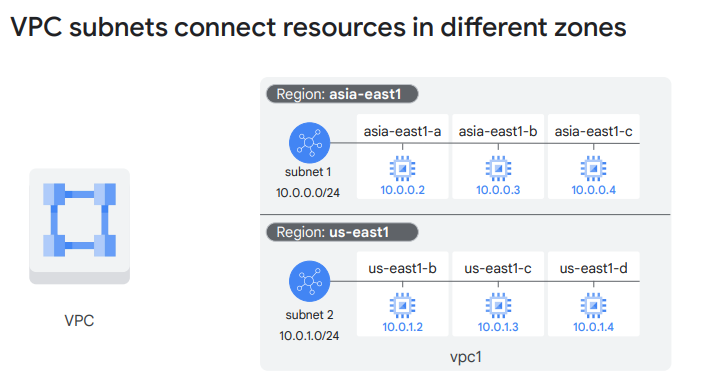A virtual private cloud, or VPC, is a secure, individual, private cloud-computing model hosted within a public cloud – like Google Cloud!
On a VPC, customers can run code, store data, host websites, and do anything else they could do in an ordinary private cloud, but this private cloud is hosted remotely by a public cloud provider. This means that VPCs combine the scalability and convenience of public cloud computing with the data isolation of private cloud computing.
VPC networks connect Google Cloud resources to each other and to the internet. This includes segmenting networks, using firewall rules to restrict access to instances, and creating static routes to forward traffic to specific destinations.
Here's something that tends to surprise a lot of new Google Cloud users: Google VPC networks are global. They can also have subnets, which is a segmented piece of the larger network, in any Google Cloud region worldwide. Subnets can span the zones that make up a region. This architecture makes it easy to define network layouts with global scope. Resources can even be in different zones on the same subnet.
The size of a subnet can be increased by expanding the range of IP addresses allocated to it. And doing so won’t affect already configured virtual machines.
For example, let’s take a VPC network named vpc1 that has two subnets defined in the asia-east1 and us-east1 regions. If the VPC has three Compute Engine VMs attached to it, it means they’re neighbors on the same subnet even though they are in different zones! This capability can be used to build solutions that are resilient to disruptions, yet retain a simple network layout.
With Compute Engine, users can create and run virtual machines on Google infrastructure. There are no upfront investments, and thousands of virtual CPUs can run on a system that is designed to be fast and offer consistent performance.
Each virtual machine contains the power and functionality of a full-fledged operating system. This means a virtual machine can be configured much like a physical server; by specifying the amount of CPU power and memory needed, the amount and type of storage needed, and the operating system.
You can create a virtual machine instance or create a group of managed instances by using the Google Cloud console, which is a web-based tool to manage Google Cloud projects and resources, the Google Cloud CLI, or the Compute Engine API.
The instance can run Linux and Windows Server images provided by Google, or any customized versions of these images. You can also build and run images of other operating systems and flexibly reconfigure virtual machines.
A quick way to get started with Google Cloud is through the Cloud Marketplace, which offers solutions from both Google and third-party vendors. With these solutions, there’s no need to manually configure the software, virtual machine instances, storage, or network settings, although many of them can be modified before launch if that’s required.
Most software packages in Cloud Marketplace are available at no additional charge beyond the normal usage fees for Google Cloud resources. Some Cloud Marketplace images charge usage fees, particularly those published by third parties, with commercially licensed software, but they all show estimates of their monthly charges before they’re launched.
At this point, you might be wondering about pricing and billing related to Compute Engine.
For the use of virtual machines, Compute Engine bills by the second with a one-minute minimum, and sustained-use discounts start to apply automatically to virtual machines the longer they run. So, for each VM that runs for more than 25% of a month, Compute Engine automatically applies a discount for every additional minute.
Compute Engine also offers committed-use discounts. This means that for stable and predictable workloads, a specific amount of vCPUs and memory can be purchased for up to a 57% discount off of normal prices in return for committing to a usage term of one year or three years.
And then there are Preemptible and Spot VMs. Let’s say you have a workload that doesn’t require a human to sit and wait for it to finish–like a batch job analyzing a large dataset, for example. You can save money, in some cases up to 90%, by choosing Preemptible VMs to run the job.
A Preemptible or Spot VM is different from an ordinary Compute Engine VM in only one respect: Compute Engine has permission to terminate a job if its resources are needed elsewhere. While savings can be had with preemptible or spot VMs, you'll need to ensure your job can be stopped and restarted.
Spot VMs differ from Preemptible VMs by offering more features. For example, preemptible VMs can only run for up to 24 hours at a time, but Spot VMs do not have a maximum runtime. However, the pricing is currently the same for both.




No comments:
Post a Comment